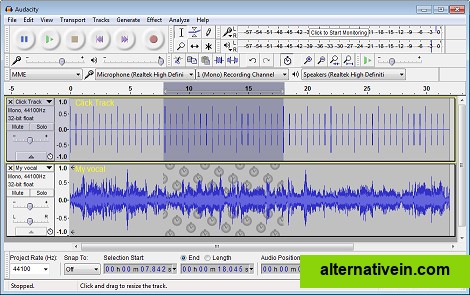

- AUDACITY EQUIVALENT FOR MAC FOR MAC
- AUDACITY EQUIVALENT FOR MAC PORTABLE
- AUDACITY EQUIVALENT FOR MAC SOFTWARE
- AUDACITY EQUIVALENT FOR MAC FREE
It is the most widely used format and is likely to be playable on any modern computer, internet connected device or portable player. If you have a choice in the matter we would suggest choosing MP3.
AUDACITY EQUIVALENT FOR MAC SOFTWARE
The following formats are widely used and if not already present on a computer, easy to use software can be easily downloaded and installed at no cost. Alternatively, you can try to ensure that the media filter doesn't attempt to process the problematic file. If this is the case then you may need to follow the Advanced Method outlined below to prepare your audio files for use within Moodle. It can however, in some rare cases cause your MP3 files to sound faster and higher pitched, making normal speech sound like Minnie Mouse, or slower and lower pitched.

Turning this on is recommended, and is a job for your Moodle administrator. Moodle has a facility called Multimedia plugins that can make the presentation of some kinds of downloaded audio and video files more streamlined.
AUDACITY EQUIVALENT FOR MAC FREE
Mammut is old software, from pre-2007, but thanks to being built in the free JUCE environment still compiles and runs nicely. Mammut is also ideal for common operations such as filtering, spectrum shift and convolution and it provides an optimal performance. The sounding results are often surprising and exciting. Mammut is a rather unpredictable program, and the user must get used to letting go of control over the time axis. In addition to being able to edit a spectrum directly, you can apply more beautiful time stretching and features like convolution, which combines audio waveforms by spectra.Īnd there’s undo/redo, too, accessed by up and down arrows in the middle of the interface, so you can back out of decisions that just screwed up the sound. These have descriptions that range from detailed and useful to glib to … tabs that have no explanation at all, or one that says “Rather useless.” You’re then able to directly manipulate the spectrum of the sound, via a seemingly random assortment of tabs with different functions. Then, with that dizzying animation looping in the background, you load a sound. You know you’re in for something out of the ordinary from the moment you launch it, and are treated to a woodcut of a woolly mammoth and some braying animal noises and … wind … or something. Mammut represents a different path to strange noises. also does granular stretching for a less spectral sound. “++spiralstretch does a pvoc stretch on realtime incoming sound with up to 8 overlapping “stretchers”.

As creator Tom Erbe wrote me (after I mentioned I loved his software for doing convolution all the way back to the mid 90s), he mentioned: If you want PaulStretch, it’s worth checking out the original, or the version now baked into free sound editor Audacity: That opened the floodgates to lots of discussion of where to find similar tools.
AUDACITY EQUIVALENT FOR MAC FOR MAC
Last week, I noticed that popular time stretching algorithm PaulStretch had found its way into a convenient plug-in form for Mac and Windows. From producing eerie, smeared convolutions of files to manipulating the spectrum of a sound in ways that are actually unlistenable (as in, they cause excruciating pain), Mammut is delightfully un-commercial and totally unpredictable. From the darkest arts in auditory alchemy, you can find gems like Mammut, a free tool that will utterly mangle digital audio into forms beautiful and chaotic.Īnd I mean really weird.


 0 kommentar(er)
0 kommentar(er)
